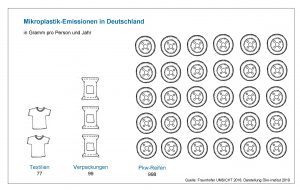#plasticfree: Everybody produces microplastics

With every piece of plastic that we use, we must ask ourselves: What could I be doing differently for me not to be needing that piece of plastic?
The nightmare has become reality
Our environment is suffocating in plastic waste: countless plastic fragments are found on riverbanks, seashores and in our soil. And in our oceans, giant swirls of plastic are floating about.
What can we all do to limit this plastic flood?
Oeko-Institute will use this blog-series as a platform to introduce ideas on how anybody can reduce their plastic consumption. Scientists working at the institute and experts of different enterprises and of civil society organizations have come together in a donation-funded creative process to provide ideas and tips.
Uncontrollable damaging of our natural livelihoods
The plastics we know today have been on the market for no longer than 60 years. What was at first considered a magical material, quickly developed into being a symbol for cheap throw-away-products. In the meantime, however, two to three generations of humans have managed to spread the waste resulting from this plastic consumption to even the most remote corners of the planet.
While plastic waste has tended to be viewed as a ‘flaw in the scenery’ up until now, it is becoming clear through scientific research that a ‘Plastocalypse’ that is, a life-threatening amount of plastic in our environment, has become reality. The continuous plastic input has led to our natural living environment being damaged beyond control.
-
In this matter, we are all the origin of the problem. Not only those that throw plastic bags in the ocean, but also the people consuming packaged goods, driving cars, throwing glitter confetti around or wearing synthetic clothes.
-
The plastic flood has global dimensions and affects almost all natural ecosystems.
-
The plastic pollution of the environment is irreversible; one cannot extract billions of small plastic particles from the ground, rivers and oceans.
-
The full dimension of the damage is not yet calculable.
Technical approaches to the issue such as eco-designs, bio-based plastics, compostable plastics and packaging recycling are not solutions to the problem, especially as more and more plastic waste continues to be accumulated. Other fields of application also contribute massively to the release of plastic particles into the environment such as the use of chemical fiber textiles and vehicle tyres. And despite good waste management practice, a large proportion of them end up in soils, rivers and seas.

Shock for German Waste Management 2018: China stops importing waste
2018 marked a major change for the German plastic and recycling industry, due to the People’s Republic of China deciding to stop importing plastic waste. Given that Germany was relying on this waste trade, this change threw Germany out of its comfort zone.
The public was also confronted with the fact that the times of waste-denial through waste-export were over. Measures such as the sorting of packaging waste into the yellow recycling sack, such as is known to us in Germany, are small steps in the right direction, but are not sufficient in order to contain the plastic flood. In the last reporting period of 2017, the amount of plastic waste has once again risen to a new record of 3,2 million tons of plastic packaging waste. Of this total, only half of the waste is reused, whilst the rest is burnt. 225.000 tons were exported for recycling. It is therefore about time to seriously start thinking about the sources of the problem.
Tackling the problem at its root: withdrawing “cold turkey” from consumption
What can be done to address the problem at its root - the mass-consumption of plastics? What would the consequences of a waiver of plastics be?
Experiences in the past have shown that reusing plastic waste is not enough to reduce plastic input into the environment. For as long as people do not question their lifestyle oriented to mass consumption, technical approaches will remain insufficient. A reduction of the use of plastics through the introduction of alternative materials could relieve the environment. Here the problem is, however, that other environmental burdens might be produced, depending on the replacement material, especially if the material if consumed as carelessly as is the case with plastic.
Options for consumers:
-
Reduce consumption: Having more time instead of consuming continuously.
-
Longer and more intensive periods of use of plastics (repair, reuse, share)
Options for politics and the economy:
-
At long last, politicians and legislators should take regulatory measures to reward the abandonment of plastics. This includes adding the cost of the environmental damage caused by plastic waste directly to the price of plastic products, for example through a plastic tax - or even better - a resource tax, the revenues of which should go directly into supporting plastic-free businesses and consumption.
-
Industry and trade can offer plastic-free alternatives to support the efforts of consumers to avoid plastics. This also includes removing especially plastic-intensive products or packaging from the market and using plastics only in deposit or reusable cycles.
Dr. Andreas Köhler, Moritz Mottschall and Martin Möller are senior researchers at Oeko-Institut in Freiburg and Berlin. As part of the donation-based project „Living without plastic – but how?“, they have been investigating the possibilities and effects of living without plastic. This includes an analysis of the reasons for using plastic, the experiences of consumers in avoiding plastic and alternative materials. The results of the project will be published in the Oeko-Institut blog under #plasticfree.